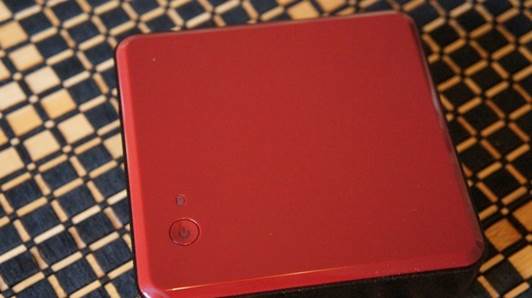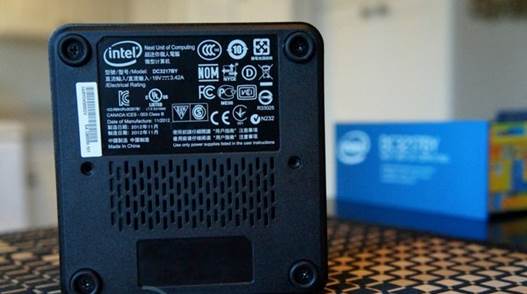Intel NUC with the components (from
NewEgg)
·
Intel NUC: $299.99
·
Intel Centrino Advanced-N 6235 U.S.: $31.99
·
Crucial DDR3 8GB (2 x 4GB) 1600MHz RAM: $77.99
·
Crucial m4 64GB SSD mSATA: $84.99
·
Wires C2G 27400: $3.99
·
Windows 8 System Builder: $99.99
·
Total: $598.94
Once properly equipped, it is obvious that
the NUC is not a cheap computer. Not that it deserves to be identified as a
low-cost computer, but it's important to lose any perspective about this cheap $300
price. At a minimum, you can plan to double its price and then, you will need
to find the keyboard, mouse and screen.
Finally in the setup process, you will need
to select the operating system and then load it up NUC. Because the machine
lacks an optical drive, the last step is a bit tired compared to the typical PC
version, but it is easy to handle. Assuming you do not have the DVD out of
hand, it's best to install the operating system through USB drive. If you are
looking to install Windows, you will need to download one from Microsoft
utility called Windows 7 USB / DVD Download Tool. Despite its name, the
software also work for Windows 8, and the need to create a flash drive can boot
from the ISO file of the Windows installation disc.
Please note that if you choose to install
Windows 8, then you have to purchase Windows 8 System Builder. Whether
Microsoft's package does not mention it, every other version of Windows 8 -
whether purchased at retail stores or as a download - is only an upgrade copy.
To increase the complexity, Windows 8 System Builder can only be bought on DVD,
which means you will need to buy a copy just to convert it to ISO file for use
with the Microsoft utility. Needless to say, Microsoft can make the process
much easier by selling Windows 8 System Builder on a flash drive.
Performance and impressions
Obviously, the NUC is a little but fast monster.
Suppose that we usually check the more powerful laptops, and HD 4000 integrated
system is not ideal for gamers (provided at 1080p 14fps speed in Euro Truck
Simulator 2, for example), but when it comes to running Windows 8 and everyday
computing tasks, NUC very interesting. The application always starts fast,
full-screen 1080p video play smoothly and web browsing extremely smoothly. Based
on our parts, the NUC can appear from the Start Screen cold start in
approximately 10 seconds, which is popular among storage systems with SSDs.

Obviously,
the NUC is a little but fast monster.
But the NUC becomes warm during these
tests, only under these conditions, the new fan noise is more than the ambient
noise. On the other hand, the system offers great silence, and even when
playing 1080p video, you will need to put your ear close to hear the fan system
- this is true even when the sound is silence.

Maybe
you're watching the NUC as a second computer.
Maybe you're watching the NUC as a second
computer. In the living room, maybe? Small size, low noise level and the
ability to easily handle 1080p video of NUC suggests it may be an ideal HTPC,
but the system still has some limitations. First, SSD storage is so expensive
and limited in size, which means you will need access personalized content over
the network or from an external hard drive. The lack of scalability of the NUC
also contributed, eliminating the possibility of adding 1 TV tuner card.
Naturally, you can always use the unit outside, but once you start adding other
devices, small size of the computer began to lose their appeal. The system also
lacked essentials such as IR capability and separate audio outputs, which will
provide more utility in the living room. Considering the positive side, NUC is
great system to play the game based on the large screen emulator.
Later this year, we can expect the launch
of Intel chips based on the Haswell microarchitecture. While we are looking
forward to see a slight increase in CPU speed, the 4th generation of Core
microprocessors will bring significant performance enhancements to the
integrated graphics chipset. No official launch date is set for Haswell, but it
is entirely reasonable for Intel NUC to be updated as part of the refresh. If
you are hesitant about the NUC, it can be a very good update waiting.
Conclusion
Now it's time to solve the questions we
raised at the beginning of this article: the NUC is actually the title of
"Next Unit of Computing" or not? Of course. The NUC emerged as an
evidence that the traditional average vertical PCs that deserve to be put aside
by ordinary consumers. The system is fast, small, energy efficient and quiet.
It shed much heritage and provides necessary things that most people need to
increase productivity and satisfying computing experience. Surely the ultra-modern
approach can concern some people, but we have seen similar reluctance when USB
drive and optical drive thrown aside, and this variation is of course continue.
As long as you are willing to accept the compromises inherent in such a small
computer, the NUC provides great incentive for you to wear gloves on and build
the next PC.

The
NUC provides great incentive for you to wear gloves on and build the next PC.
Info
·
Price: $300
Advantages
·
Fast and simple hardware setup
·
Great performance for common tasks
·
Small size, VESA-mountable
·
Barely audible fan noise
Disadvantages
·
No native USB 3.0
·
Pricey once you factor in all the components
Overview
·
The NUC's small size, reasonable price and solid
performance make it an ideal PC for those who want to build a system themselves
on a budget. Just get ready to put on your gloves in setting it up.
|
Specifications
·
Type: small form-factor
·
CPU Family: Core i3
·
CPU model: 3217U
·
Processor speed: 1.8 GHz
·
Numbers of CPUs: 2
·
System RAM: 16GB
·
RAM bus/speed: DDR3 (1600)
·
RAM Slots: 2
·
Hard drive(s): 180 GB (total) SSD
·
Video outputs: HDMI
·
Dimensions: 1.54 x 4.59 x 4.41 inches
·
Chipset: Intel
·
Expansion card slot : PCI Express Mini
|